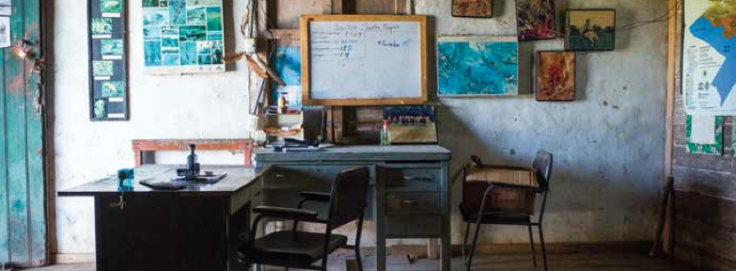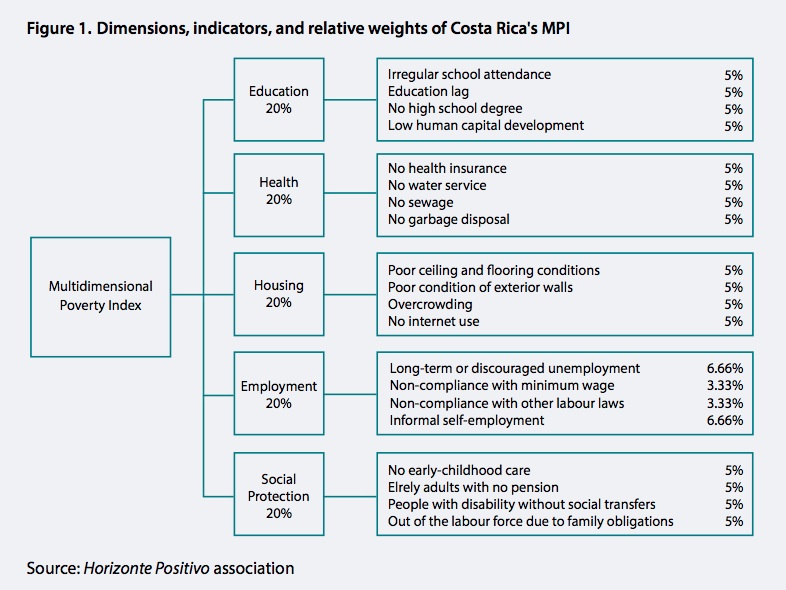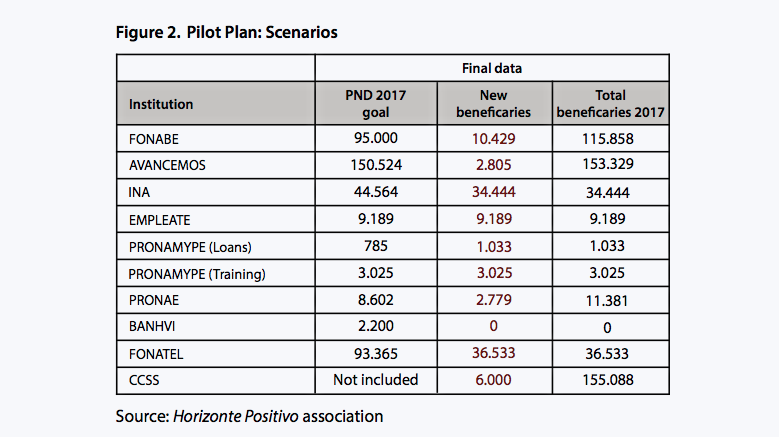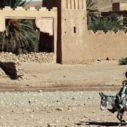
Search
Using the MPI to Determine National Budgets in Costa Rica

Costa Rica’s Multidimensional Poverty Index was created in 2015 through a partnership between the public and private sectors, along with OPHI, as a complement to income-based poverty measurement. Two years later, the index is being used as the main criterion for budget allocation in public institutions responsible for social programmes.
Costa Rica’s Multidimensional Poverty Index (MPI-CR) was the result of a joint effort by the government of Costa Rica, the National Institute of Statistics and Censuses (INEC), the Horizonte Positivo association, and the Oxford Poverty and Human Development Initiative (OPHI). This public-private partnership was responsible for identifying the five dimensions and 19 indicators that make up the index. These indicators were chosen based on the information available in INEC’s National Household Survey (ENAHO). This is an annual survey and the data within the survey is comparable since 2010. The Alkire-Foster methodology was used for this exercise.
A particular feature of the MPI-CR is its use of indicators that had not been considered in other countries’ measures, such as Internet use and noncompliance with minimum wage or other labour rights. In Costa Rica, households with deprivations in 20% of the indicators are considered multidimensionally poor. In 2016, 20.5% of households were identified as poor by the MPI-CR.
An MPI for better institutional governance
Between 1987 and 2016, public spending on Costa Rica’s social sector increased considerably: more than sevenfold for education and by almost fivefold for both health and public investment for poverty reduction. However, poverty (measured in monetary terms) did not decline proportionally, and no systems were created to monitor or coordinate the poverty reduction programs. Many of the social benefits were delivered without being subject to technical guidelines or empirical evidence, and without knowing the needs of the population. Consequently, the poverty mitigation efforts were not producing the expected results.
In late 2014, the Government of Costa Rica introduced the 2015–2018 National Development Plan (PND in Spanish), led by the Office of the Vice President, to coordinate the work of public institutions and their social programs in the different regions of the country in order to improve poverty reduction measures.
The Government of Costa Rica created a commission with representatives from the Presidential Social Council Advisory Team, the Ministry of National Planning and Economic Policy (Mideplan), the Ministry of Finance, the Fund for Social Development and Family Benefits (Fodesaf), and the Horizonte Positivo association with the goal of incorporating the MPI-CR as an official measure for allocating resources and monitoring and evaluating social programs.
Educating and training mid-level officials has been essential for this measurement to be truly incorporated into the day-to-day work of public institutions.
This commission used the MPI-CR to identify trends for each dimension and indicator at the national and regional level. It also compared those trends in deprivations with what was being done by the central government’s social programs. The result was illuminating: There were significant opportunities for improving the allocation of resources to ensure that the largest investments went to the areas most in need.
This commission presented the proposal to use the MPI-CR for an efficient allocation of resources to the cabinet in March 2016, a meeting attended by the President and ministers from several institutions. The cabinet came to the following agreement: ‘To request all officials and mid-level officials from the social sector ministries and institutions to use the Multidimensional Poverty Index [MPI-CR] as an official diagnostic and monitoring tool for social programs, as well as part of the criteria for allocating resources to the different regions of the country and programs with the largest impact on reducing the index’ (Government Council Agreement N* 092-16).
Then, in May 2016, a Presidential Directive (N* 045) was issued stating that the MPI-CR must be used by a set of institutions for budgetary planning: ‘The officials and mid-level officials of social sector ministries and institutions will use the Multidimensional Poverty Index [MPI-CR] as an official measure for allocating resources and for monitoring and evaluation of social programs’.
After the publication of this directive, a pilot plan was conducted with seven key institutions in which the MPI-CR was used for planning their 2017 budgets. Resources were allocated following the PND goals for each institution but using MPI data for establishing new beneficiaries for 2017, as well as defining the total number of beneficiaries. Workshops were then held to train the institutions in how to target those resources using the MPI-CR data, using 2017 as a baseline. After a series of meetings, the final data were available. Some institutions argued that part of their resources had already been allocated to old beneficiaries, but they pledged to use the MPI-CR data for allocations to new beneficiaries.
Each institution estimated its potential number of final beneficiaries. For example, the PND allocated resources for 95,000 scholarships to the National Scholarship Fund (Fonabe). Fonabe stated that 10,429 new beneficiaries could be targeted using the MPI-CR (see figure 2). This has a direct impact on the index’s education dimension, specifically on the indicator related to school attendance.
For 2018, the number of programmes has been increased to 18 from 14 different institutions. A baseline was established based on these programmes, and workshops were held to explain the MPI-CR, how to use it, which data to use, and how each institution can target resources using this index.
Simulations were then carried out for each indicator and region of the country using this data in order to estimate how the allocation of resources using the MPI-CR in the 18 programs would affect poverty levels. The current poverty level in Costa Rica is 20.5% (2016). If resources are distributed as proposed, poverty could fall by 1.8 or 2.1 percentage points.
Social Management Dashboard
The Ministry of Finance also wanted to develop a tool that would help the government justify public spending to taxpayers using empirical evidence.
Thus, a Social Management Dashboard was proposed for this purpose, specifically, a traffic light system where a green light signals situations that are going well, yellow those that need attention, and red those with problems. It is particularly important to identify the latter so that appropriate corrective measures can be made in real time to ensure that the program goals are fulfilled. This is not meant to be an intrusive tool; rather, its goal is to give people access to higher levels of wellbeing through the correct use of resources.
This dashboard will not only determine whether resources are being used correctly but also establish the number of beneficiaries who will be reached through these programs.
How was the MPI-CR incorporated into public policy?
Collaboration at different levels was one of the key variables in incorporating the MPI-CR into public policy. Senior- and mid-level officials showed great leadership by coordinating the work both within institutions, such as the Ministry of Finance and Planning, and with external actors, such as those in academia and the private sector.
This work has been well received by institutions interested in applying the MPI-CR. Educating and training employees has been essential for this measurement to be truly incorporated into the day-to-day work of public institutions.
The challenge ahead is to incorporate the MPI-CR into the budget process of every public institution so that it is used in a continuous and decisive way.
*Original in Spanish. Translated by Caitlin Jones, United Nations Volunteer. Revised by Diego Zavaleta and Ann Barham.


















